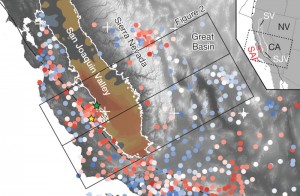Image courtesy of UC Berkeley [1]
[1]
GPS measurements show that the Sierra Nevada and Coast Ranges rise several millimeters per year (red dots) as a result of groundwater pumping in the Central Valley (brown). Blue dots are sites where the ground has subsided.
The weight of water pumped from California’s agricultural heartland, the Central Valley, over the past 150 years is enough to allow Earth’s crust to rebound upward, raising surrounding mountain ranges, the Sierra Nevada and Coast Ranges, some six inches. Winter rains and summer pumping cause annual up and down movements that could affect earthquakes on the San Andreas Fault, which parallels the ranges. (source [2])
Extracting water for human activities is increasing the number of earthquakes being triggered in California.
A new study suggests that the heavy use of ground water for pumping and irrigation is causing mountains to lift and valleys to subside.
The San Andreas fault runs for almost 1,300km through the western part of California and marks part of the boundary between the Pacific and North American tectonic plates.
Seismologists have mainly focussed on the movements of these plates as the critical factors in the build up of stress that can lead to large earthquakes, such as the one that destroyed San Francisco in 1906.
This paper looks at another factor – the impacts of humans on the Earth’s surface.
The researchers have used the well developed GPS system in the western US to analyse small lifts and dips in the topography of the San Joaquin valley.
San Joaquin is part of California’s central valley, one of the most productive farm regions in the US. That productivity is based on access to groundwater, extracted and pumped to irrigate crops.
So great is the demand that scientists estimate twice as much water is being consumed as is being returned through rain and snow.
Experts are worried that over time this will hasten the occurrence of large quakes.
“We are removing a weight from the Earth’s crust and it is responding by flexing upwards and literally moving mountains,” lead author Dr Colin Amos said.
“It seems as though these small stress changes that happen on a yearly basis, are causing more small earthquakes to occur on portions of the fault.”
In another part of the region along the southern Sierra Nevada mountain range, scientists had believed that the crustal uplift was due to tectonic forces.
This new research indicates that it too is partly a consequence of groundwater depletion.
Dr Amos believes the study shows that we need to think more broadly about the impact of our actions in relation to nature.
”Human activities are changing things that we hadn’t appreciated before – its a wake up call to the far reaching implications for the things that we are doing that may affect systems that we didn’t know that we could affect.”
Sources:
Science Daily [2]
Uplift and seismicity driven by groundwater depletion in central California. Nature, 2014; DOI: 10.1038/nature13275 [3]
